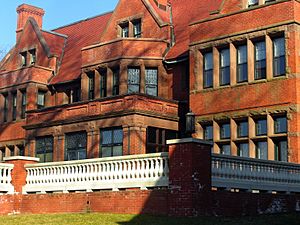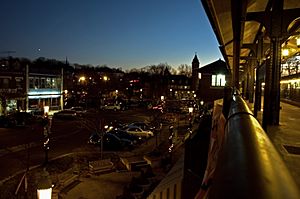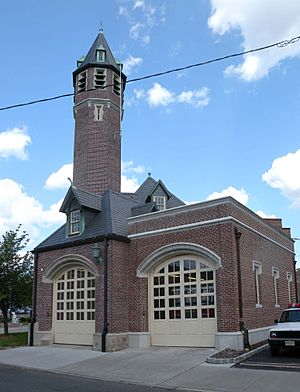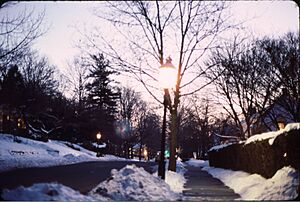South Orange, New Jersey facts for kids
Quick facts for kids
South Orange, New Jersey
|
||
|---|---|---|
|
Village
|
||
| South Orange Village (until April 25, 2024) | ||
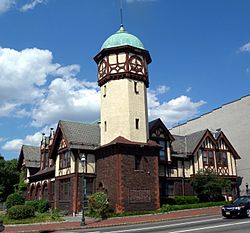
South Orange village hall
|
||
|
||
| Country | ||
| State | ||
| County | Essex | |
| Incorporated | May 4, 1869 | |
| Government | ||
| • Type | Special charter | |
| • Body | Board of Trustees | |
| Area | ||
| • Total | 2.85 sq mi (7.38 km2) | |
| • Land | 2.85 sq mi (7.37 km2) | |
| • Water | <0.01 sq mi (<0.01 km2) 0.07% | |
| Area rank | 349th of 565 in state 17th of 22 in county |
|
| Elevation | 138 ft (42 m) | |
| Population
(2020)
|
||
| • Total | 18,484 | |
| • Estimate
(2023)
|
18,208 | |
| • Rank | 147th of 565 in state 13th of 22 in county |
|
| • Density | 6,494.7/sq mi (2,507.6/km2) | |
| • Density rank | 81st of 565 in state 11th of 22 in county |
|
| Time zone | UTC−05:00 (Eastern (EST)) | |
| • Summer (DST) | UTC−04:00 (Eastern (EDT)) | |
| ZIP Code |
07079
|
|
| Area code(s) | 973 and 862 | |
| FIPS code | 3401369274 | |
| GNIS feature ID | 1867376 | |
South Orange is a historic suburban community located in Essex County, New Jersey. It's right next to the city of Newark. For a long time, it was known as the Township of South Orange Village.
In 2020, about 18,484 people lived here. This was a good increase from the 2010 population. Seton Hall University, a well-known college, is also located in South Orange.
The name "South Orange" might have come from Mr. Nathan Squier, who used it in an advertisement in 1795. Another idea is that the name, like other "Orange" towns nearby, came from King William III, who was also the Prince of Orange.
South Orange is special because it's one of only four places in New Jersey that still has a "village" type of government. On April 25, 2024, the name officially changed to "South Orange Village." The local leaders are now called the council and mayor, instead of the board of trustees and president.
Contents
- Exploring South Orange's Past
- Historic Places in South Orange
- What Makes South Orange Unique?
- South Orange's Geography
- Who Lives in South Orange?
- Parks and Fun Activities
- Arts and Culture Scene
- Learning in South Orange
- Getting Around South Orange
- Local News and Media
- Interesting Facts About South Orange
- Images for kids
- See also
Exploring South Orange's Past
South Orange Village was first created on May 4, 1869. It was part of a larger area called South Orange Township, which is now known as Maplewood. Later, in 1904, South Orange officially became its own separate village.
In 1978, the village changed its name to "The Township of South Orange Village." This was done to get more money from the government. Many other towns in Essex County did the same thing.
Early Settlements and Names
The land where South Orange is today was bought from the Lenape Native Americans in 1666. This was done by Robert Treat, who also started the city of Newark. At first, the areas north and west of Newark were called the "uplands." South Orange was even called "Chestnut Hills" for a while.
Two families, the Browns and the Riggs, were among the first English settlers here in the late 1600s. They started farms and built houses. One of the oldest surviving buildings in South Orange is called the "Stone House." It's believed to have been built around 1756 or even earlier.
Growing into a Community
By 1800, the area was known as "South Orange." The name "Orange" came from William of Orange, the ruler of England. South Orange became part of Orange Township in 1806. Later, it was part of Clinton Township and then South Orange Township.
In 1869, South Orange Village separated from South Orange Township. People wanted more control over their local affairs. After the American Civil War, South Orange became a quiet place for people who wanted to escape busy city life.
Around 1830, South Orange had about 30 homes, a hotel, a store, a paper mill, and a church.
Travel and Development
The Morris and Essex Railroad came to South Orange in 1837. This made it easier to travel to places like Newark and Morristown. By 1869, this railroad became part of a bigger line that went all the way to Chicago!
The Montrose neighborhood grew after the Civil War. Rich families from Newark and New York City built large houses there. The Orange Lawn Tennis Club started in Montrose in 1880. It even hosted the first US national tennis championships in 1886.
The Baird Community House was once a clubhouse for a golf course. This golf course covered what is now Meadowlands Park. Village Hall was built in 1894, and the old library in 1896. These buildings show how much the village was growing.
Electric trolley cars started running in 1893. The railroad tracks were raised above street level between 1914 and 1916. This made travel safer and faster. In 1930, Thomas Edison helped start electric train service.
The South Orange Library Story
The South Orange Library Association began in 1864. People donated books, and the library moved a few times as it grew. At first, it was supported by members' fees and gifts.
In 1886, a new group formed to create a free library. The library even hosted Village Trustees meetings before Village Hall was built. In 1895, Eugene V. Connett offered land for a new library building.
The library moved into its own building in 1896. In 1926, the town voted to fully support the library. In 1929, a new section was added, including a Children's Room. The current library building opened in 1968.
Modern Growth and Commuting
In the 1920s, South Orange became a "bedroom community." This meant many residents lived here but worked in Newark or New York City. Large houses were built, especially around the Orange Lawn Tennis club.
Today, the old Morris and Essex Railroad is run by NJ Transit. Since 1996, the "Midtown Direct" service has allowed direct trains to Penn Station in Midtown Manhattan. This made the commute much shorter, from 50 minutes to about 35 minutes. Because of this, house prices went up. Many people want parking permits for the train station, and there's a long waiting list!
Historic Places in South Orange
South Orange has many places listed on the State and National Historic Registers. These are important sites that tell the story of the village.
- Old Stone House: This house, first mentioned in 1680, is one of the oldest buildings.
- Baird Community Center: This center offers arts programs, including the Pierro Gallery.
- Chapel of the Immaculate Conception: This chapel is a main part of the Seton Hall University campus.
- Montrose Park Historic District: A neighborhood with many historic homes.
- Mountain Station Railroad Station: An old train station.
- South Orange Fire Department: The historic fire station.
- South Orange station: The main train station, built in 1916.
- South Orange Village Hall: The village's main government building, built in 1894.
- Temple Sharey Tefilo-Israel: A historic temple.
What Makes South Orange Unique?
South Orange is one of the few places in New Jersey that still uses gas lights for its streets. These gaslights, along with the special Village Hall, are symbols of South Orange. Many residential streets still have them. Some people say South Orange has more working gaslights than any other community in the United States!
The houses in South Orange are very different. You can find many styles, from small brick cottages to large mansions. You'll see Tudor, Victorian, Colonial, and other styles.
Many people who live here travel to New York City for work. But others work in South Orange or other parts of New Jersey. The village has a downtown area with restaurants, banks, and shops. Seton Hall University is the largest business here.
South Orange's Geography
South Orange covers about 2.85 square miles (7.38 square kilometers) of land. It's surrounded by other towns in Essex County, like Maplewood, Newark, and West Orange.
The East Branch of the Rahway River flows through the village. It's usually a small stream, but it can get bigger after rain. In the past, it sometimes flooded, but flood control projects in the 1970s helped fix this.
The western part of town is on the eastern side of South Mountain. The edge of town runs along the South Mountain Reservation, a large park area. South Orange also has different neighborhoods like Montrose, Newstead, Tuxedo Park, and Wyoming.
Weather in South Orange
South Orange has a humid continental climate. This means it has warm summers and cold winters.
| Climate data for South Orange | |||||||||||||
|---|---|---|---|---|---|---|---|---|---|---|---|---|---|
| Month | Jan | Feb | Mar | Apr | May | Jun | Jul | Aug | Sep | Oct | Nov | Dec | Year |
| Mean daily maximum °F (°C) | 35.6 (2.0) |
39.2 (4.0) |
46.8 (8.2) |
57.9 (14.4) |
68.5 (20.3) |
77.2 (25.1) |
83.8 (28.8) |
81.9 (27.7) |
75 (24) |
63 (17) |
50.9 (10.5) |
41.9 (5.5) |
60.1 (15.6) |
| Mean daily minimum °F (°C) | 24.3 (−4.3) |
25.9 (−3.4) |
33.3 (0.7) |
43.3 (6.3) |
53.1 (11.7) |
61.5 (16.4) |
67.8 (19.9) |
67.3 (19.6) |
60.1 (15.6) |
50.4 (10.2) |
38.8 (3.8) |
31.1 (−0.5) |
46.4 (8.0) |
Who Lives in South Orange?
| Historical population | |||
|---|---|---|---|
| Census | Pop. | %± | |
| 1880 | 2,178 | — | |
| 1890 | 3,106 | 42.6% | |
| 1900 | 4,608 | 48.4% | |
| 1910 | 6,014 | 30.5% | |
| 1920 | 7,274 | 21.0% | |
| 1930 | 13,630 | 87.4% | |
| 1940 | 13,742 | 0.8% | |
| 1950 | 15,230 | 10.8% | |
| 1960 | 16,175 | 6.2% | |
| 1970 | 16,971 | 4.9% | |
| 1980 | 15,864 | −6.5% | |
| 1990 | 16,390 | 3.3% | |
| 2000 | 16,964 | 3.5% | |
| 2010 | 16,198 | −4.5% | |
| 2020 | 18,484 | 14.1% | |
| 2023 (est.) | 18,208 | 12.4% | |
| Population sources: 1880–1890 1880–1920 1890–1910 1880–1930 1940–2000 2000 2010 2020 |
|||
South Orange is a diverse and thriving community. It has one of the largest Jewish communities in Essex County.
Population Details
In 2020, the village had 18,484 people. The community is made up of people from many different backgrounds.
In 2010, there were 16,198 people living in South Orange. About 60% were White, 28% were Black or African American, and 5% were Asian. About 6% of the population was Hispanic or Latino.
Parks and Fun Activities
South Orange has a public swimming pool that all residents can use. It's special because it was built on land given to the town for everyone to enjoy. This means it's very affordable for residents to get an annual pass. The original pool was built in the 1920s and was one of the first free community pools in the U.S. It was replaced with a bigger pool in 1972.
The South Orange River Greenway is a new project. It will be a path for bikes and walkers, connecting parts of South Orange and Maplewood.
Other parks in the village include Grove Park, New Waterlands Park, Flood's Hill (a popular sledding spot), Cameron Field, and Farrell Field.
Arts and Culture Scene
The Baird Center, located in Meadowland Park, is a hub for fun activities. It hosts arts programs, like the Pierro Gallery of South Orange, and The Theater on 3. It also has preschool and other educational programs. The Baird Center is being updated to make it even better.
The Pierro Gallery shows art from modern artists and helps local artists. They often have shows featuring artists from Essex County.
The South Orange Performing Arts Center (SOPAC) is a great place to see shows. It has a theater with 415 seats and a cinema with five screens. SOPAC hosts music, family shows, dance, theater, and comedy throughout the year. It also partners with Seton Hall University for classical concerts and student plays.
SOPAC was planned in the mid-1990s to help improve the downtown area. It opened to the public in 2006.
The South Orange Symphony, started in 1949, is an orchestra made up of volunteer musicians. They play classical music and offer three free concerts each year.
Learning in South Orange
South Orange shares a school system with Maplewood, called the South Orange-Maplewood School District. The district has one high school, two middle schools, a preschool, and several elementary schools.
Local Schools
As of 2019–2020, the district had about 7,353 students in 11 schools. The schools include:
- Montrose Early Childhood Center (preschool, Maplewood)
- Seth Boyden Elementary Demonstration School (K–5, Maplewood)
- Clinton Elementary School (K–5, Maplewood)
- Jefferson Elementary School (3–5, Maplewood)
- Marshall Elementary School (K–2, South Orange)
- South Mountain Elementary School (K–5, South Orange)
- South Mountain Elementary School Annex (K–1, South Orange)
- Tuscan Elementary School (K–5, Maplewood)
- Maplewood Middle School (6–8, Maplewood)
- South Orange Middle School (6–8, South Orange)
- Columbia High School (9–12, Maplewood)
Private Schools
Our Lady of Sorrows School is a K–8 elementary school. It's run by the Roman Catholic Archdiocese of Newark.
College Education
Seton Hall University is a large university in South Orange. It was founded in 1856 and is named after Elizabeth Ann Seton, the first American Catholic saint. About 9,700 students attend Seton Hall.
Getting Around South Orange
South Orange has about 48.76 miles of roads. Most of these are maintained by the village itself.
Main Roads
Important county roads include County Route 510 (South Orange Avenue) and County Route 577 (Wyoming Avenue). Other local roads are Valley Street, Scotland Road, Irvington Avenue, and Centre Street.
Public Transportation Options
South Orange has two NJ Transit train stations: the South Orange station and the Mountain Station. These stations offer train service on the Morris and Essex Line. You can travel to Newark Broad Street Station and then to New York Penn Station or Hoboken Terminal.
NJ Transit also has three bus lines that go through South Orange:
- The 92 route goes from the South Orange train station to Branch Brook Park in Newark.
- The 107 route goes from the South Orange Train Station to the Port Authority Bus Terminal in New York City.
- The 31 bus line travels between South Orange and Newark Penn Station.
There's also a shuttle that connects South Orange to Livingston.
Local News and Media
- WSOU-FM: This is "Seton Hall's Pirate Radio," a college radio station that broadcasts at 89.5 FM.
- The News-Record: A weekly newspaper that covers news for both South Orange and Maplewood.
- "The Village Green": A website that shares local news and events for South Orange and Maplewood.
- South Orange Patch: Provides local news, events, and headlines.
- The Gaslight: A newsletter from the local government that shares updates about South Orange.
Interesting Facts About South Orange
- South Orange was the first town in the country to have an "affinity credit card." This idea was started by a former village president, William Calabrese.
- When telephones and electricity first came to South Orange, the wires and poles were often placed in the middle of blocks or underground. This makes the town look nicer, but it made it harder to get cable television at first.
- The telephone numbers used in South Orange and Maplewood (like 761, 762, 763) originally came from the old "South Orange" exchange names.
- South Orange was the first town in New Jersey to recognize civil unions for same-sex couples.
Images for kids
See also
 In Spanish: South Orange para niños
In Spanish: South Orange para niños






